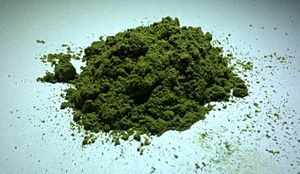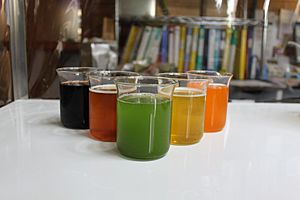Instant tea facts for kids

Instant tea is a special powder that you mix with water to make a cup of tea. It's like instant coffee, but for tea! The very first instant tea was made in the United Kingdom in 1885. It was a thick paste of tea, sugar, and milk. You just added hot water to it. Later, new technology called spray drying made it possible to dry tea without losing its yummy flavors.
Contents
What's in Instant Tea?
Instant tea powder is basically the dried-up flavor, smell, and color of tea. When you buy it, other things might be added. These can include sugar to make it sweet, citric acid to make it a bit tart, or other flavors like raspberry or lemon.
When you mix the powder with water, it dissolves completely. This means all the flavor and color spread out evenly in the water. So, your instant tea is a smooth, even drink.
How Instant Tea is Made
Making instant tea involves several steps. Think of it like a journey for the tea leaves!
The main steps are:
- Choosing the right tea leaves
- Getting the good stuff out of the leaves (extraction)
- Capturing the tea's smell (aroma stripping)
- Dealing with "tea cream"
- Making the tea liquid stronger (concentration)
- Turning it into powder (drying)
Picking the Tea Leaves
Tea makers choose leaves that are good quality and also affordable. Often, they use black tea leaves that have been fermented but not yet dried. These leaves are cheaper to buy. But don't worry, they still make great-tasting instant tea!
Getting the Flavor Out (Extraction)
This step is about getting all the tasty parts out of the tea leaves. The leaves are mixed with a liquid, usually water, to pull out the tea compounds. Some parts of the tea dissolve super fast because they are on the surface of the leaf. Other parts take a bit longer because they are deeper inside. Scientists have found ways to get out about 35% of the good stuff from the leaves. After this, the tea liquid is cleaned by passing it through special filters.
Saving the Smell (Aroma Stripping)
Tea has a wonderful smell, called its aroma. This step makes sure that smell doesn't get lost! A gas, like steam or nitrogen, is passed through the tea liquid. This gas picks up the tiny aroma particles. Imagine blowing bubbles in your drink; the gas takes the smell with it. To get the most smell, they make the gas bubbles as small as possible. Using gases like nitrogen also helps keep the aroma fresh.
Dealing with "Tea Cream"
Sometimes, when black tea cools down, it can get cloudy. This cloudy stuff is called "tea cream." It happens because some parts of the tea don't dissolve easily and stick together. These parts include things that give tea its color and flavor.
In America, people expect instant tea to be clear, not cloudy. So, manufacturers have special ways to stop the cream from forming. One way is to use a special enzyme. Another way is to remove the bigger particles that cause the cloudiness, while keeping the good flavor parts.
Making it Stronger (Concentration)
After getting the flavor out and dealing with the cream, the tea liquid is still mostly water. It's too watery to turn into powder right away. So, they need to make it stronger. This is done by removing a lot of the water through evaporation. They do this at lower temperatures to protect the tea's flavor. The aroma is usually captured before this step so it doesn't get lost.
Turning it into Powder (Drying)
The final step is turning the strong tea liquid into a powder. The most common way to do this is called spray drying. It's a clever method! The tea liquid is sprayed through a tiny nozzle, turning it into very fine droplets. These tiny droplets meet hot air. The water in the droplets quickly evaporates, leaving behind only the dry tea powder. The powder is dried until it has very little water left, usually about 3-5%. This helps it last a long time on the shelf.


